Introduction
Rocket Propulsion in a broad sense is the act of changing the motion of a body. Propulsion mechanisms provide a force that moves bodies that are initially at rest, changes a velocity, or overcomes retarding forces when a body is propelled through a medium. Jet propulsion is a means of locomotion whereby a reaction force is imparted to a device by the momentum of ejected matter.The energy source most useful to rocket propulsion is chemical combustion. Energy can also be supplied by solar radiation and, in the past, also by nuclear reaction.
Classification
Rocket Propulsion is mainly divided into two categories:-
- Duct Jet Propulsion:-a class of jet propulsion and includes turbojets and ramjets; these engines are also commonly called air-breathing engines. Devices utilize mostly the surrounding medium as the “working fluid“, together with some stored fuel.
- Rocket propulsion :- a class of jet propulsion that produces thrust by ejecting stored matter, called the propellant. Devices can be divided into chemical propulsion, nuclear propulsion, and solar propulsion.
Duct Jet Propulsion
This class, also called air-breathing engines, comprises devices which have a duct to confine the flow of air. They use oxygen from the air to burn fuel stored in the flight vehicle. The class includes turbojets, turbofans, ramjets, and pulse-jets.This class of propulsion is mentioned primarily to provide a comparison with rocket propulsion and a background for combination rocket-duct engines, which are mentioned later. A high specific impulse is directly related to a long flight range and thus indicates the superior range capability of air breather engines over chemical rockets at relatively low altitude. The uniqueness of the rocket, for example, high thrust to weight, high thrust to frontal area, and thrust independence of altitude, enables extremely long flight ranges to be obtained in rarefied air and in space.The turbojet engine is the most common of ducted engines.
Rocket propulsion
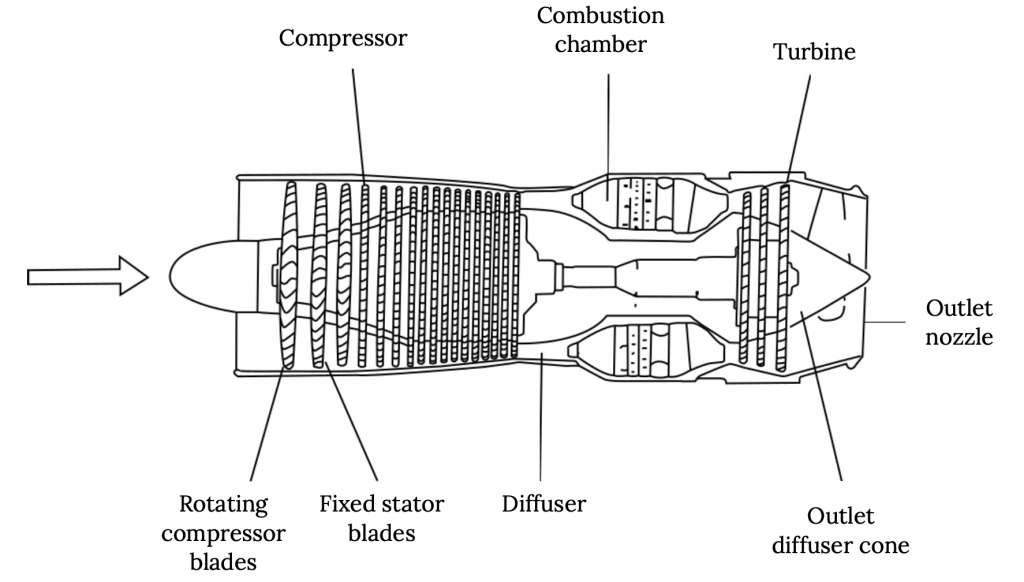
Rocket propulsion systems can be classified according to the type of energy source (chemical, nuclear, or solar), the basic function (booster stage, sustainer, attitude control, orbit station keeping, etc.), the type of vehicle (aircraft,missile, assisted take-off, space vehicle, etc.), size, type of propellant, type of construction, or number of rocket propulsion units used in a given vehicle. This same Thermodynamics theory and the same generic equipment (nozzle) is used for jet propulsion, rocket propulsion, nuclear propulsion, laser propulsion, solar-thermal propulsion, and some types of electrical propulsion. Totally different methods of producing thrust are used in other types of electric propulsion or by using a
pendulum in a gravity gradient.
Chemical Rocket Propulsion
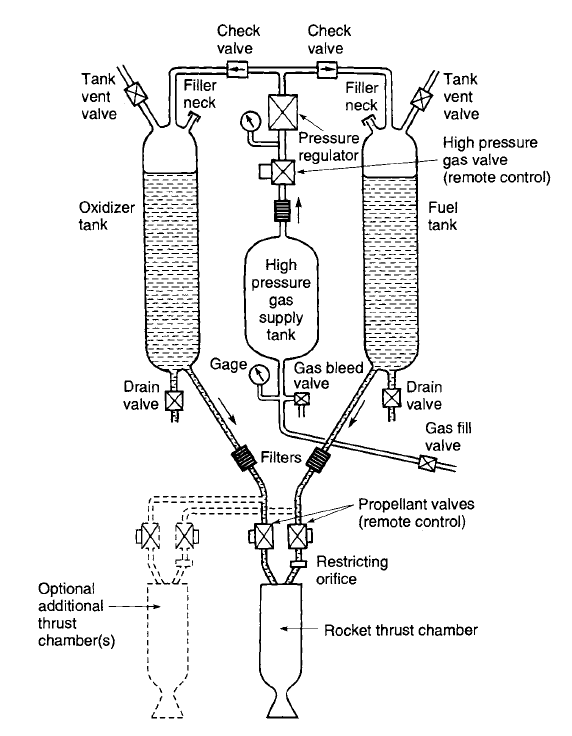
The energy from a high-pressure combustion reaction of propellant chemicals, usually a fuel and an oxidizing chemical, permits the heating of reaction product gases to very high temperatures (2500 to 4100°C or 4500 to 7400°F). These gases subsequently are expanded in a nozzle and accelerated to high velocities (1800 to 4300 m/sec or 5900 to 14,100 ft/sec). Since these gas temperatures are about twice the melting point of steel, it is necessary to cool or insulate all the surfaces that are exposed to the hot gases. According to the physical state of the propellant, there are several different classes of chemical rocket propulsion devices.
Liquid propellant rocket engines use liquid propellants that are fed under pressure from tanks into a thrust chamber. A typical pressure-fed liquid propellant rocket engine system is schematically . The liquid bi-propellant consists of a liquid oxidizer (e.g., liquid oxygen) and a liquid fuel (e.g., kerosene). A mono-propellant is a single liquid that contains both oxidizing and fuel species; it decomposes into hot gas when properly catalyzed. Gaseous propellant rocket engines use a stored high-pressure gas, such as air, nitrogen, or helium, as their working fluid or propellant. The stored gas requires relatively heavy tanks.
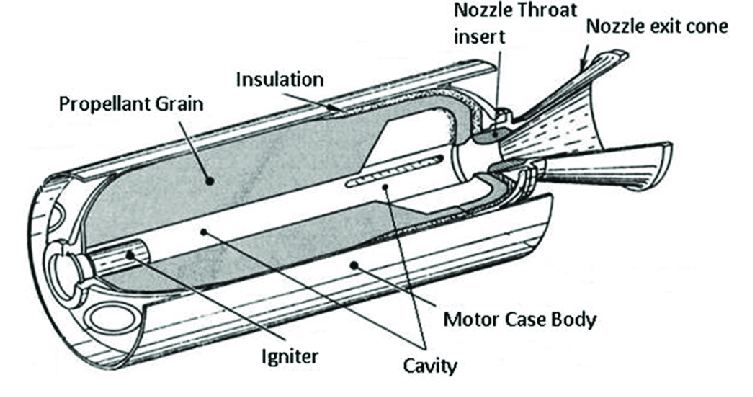
Electric Rocket Propulsion
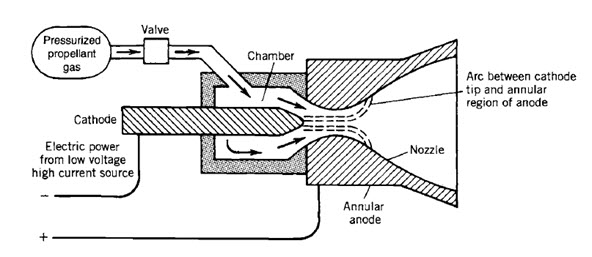
In all electric propulsion the source of the electric power (nuclear, solar radiation receivers, or batteries) is physically separate from the mechanism that produces the thrust. This type of propulsion has been handicapped by heavy and inefficient power sources. The thrust usually is low, typically 0.005 to 1 N.
In order to allow a significant increase in the vehicle velocity, it is necessary to apply the low thrust and thus a small acceleration for a long time
other Rocket Propulsion Concepts
Several technologies exist for harnessing solar energy to provide the power for spacecraft and also to propel spacecraft using electrical propulsion. Solar cells generate electric power from the sun’s radiation. They are well developed and have been successful for several decades. Most electric propulsion systems have used solar cells for their power supply.
Application of rocket propulsion
Because the rocket can reach a performance unequaled by other prime movers,
it has its own fields of application and does not usually compete with other
propulsion devices.
space launched vehical
Between 1957 and 1998, there were approximately 4,102 space launch attempts worldwide, with about 129 failures. Space launch vehicles, or boosters, can be classified as expendable or reusable, based on aspects like propellant type (solid, storable, or cryogenic liquid), number of stages (single-stage, two-stage, etc.), payload size, and whether they are manned or unmanned. Multistage launch vehicles consist of separate stages, each functioning as a complete vehicle with its own propellant, propulsion, and control systems. The initial booster stage, the largest, operates first, separating from the vehicle before igniting the next stage, which allows for increased terminal velocity by shedding dead weight from expended stages. Both solid and liquid propellant systems are employed for low Earth orbits. Between 1957 and 1998, there were around 4,102 space launch attempts across the globe, resulting in about 129 failures. Boosters can be categorized as expendable or reusable, depending on factors like propellant type, number of stages, payload size, and whether they are crewed or uncrewed. Multi-stage launch vehicles are composed of separate stages, each functioning as an independent vehicle with its own propellant, propulsion, and control systems. The initial booster stage, the largest one, operates first, detaching from the vehicle before igniting the subsequent stage to enhance terminal velocity by shedding weight from expended stages. Both solid and liquid propellant systems are utilized for low Earth orbits.
Spacecraft
Depending on their missions, spacecraft can be categorized as earth satellites,lunar, interplanetary, and trans-solar types, and as manned and unmanned spacecraft. Rocket propulsion is used for both primary propulsion along the flight path, such as for orbit insertion or orbit change maneuvers) and secondary propulsion functions in these vehicles. Some of the secondary propulsion functions are attitude control, spin control, momentum wheel and gyro unloading, stage separation, and the settling of liquids in tanks. A spacecraft usually has a series of different rocket propulsion systems, some often very small. For spacecraft attitude control about three perpendicular axes, each in two rotational directions, the system must allow the application of pure torque for six modes of angular freedom, thus requiring a minimum of 12 thrust chambers. Some missions require as few as four to six rocket units whereas the more complex manned spacecraft have 40 to 80 rocket units in all of its stages. Often the small attitude control rockets must give pulses or short bursts of thrust, necessitating thousands of restarts.
Missiles and Other Applications
Military missiles can be classified as shown in Table 1-6. Rocket propulsion for new U.S. missiles uses now almost exclusively solid propellant rocket motors.They can be strategic missiles, such as long-range ballistic missiles (800 to 9000 km range) which are aimed at military targets within an enemy country, or
tactical missiles, which are intended to support or defend military ground forces, aircraft, or navy ships.
The term surface launch can mean a launch from the ground, the ocean surface (from a ship), or from underneath the sea (submarine launch). Some tactical missiles, such as the air-to-surface SRAM missile, have a two-pulse solid propellant motor, where two separate, insulated grains are in the same motor case; the time interval before starting the second pulse can be timed to control the flight path or speed profile. Most countries now have tactical missiles in their military inventories, and many of these countries have a capability to produce their own rocket propulsion systems that are used to propel them. Other applications of rockets include primary engines for research airplanes, assist-take-off rockets for airplanes, ejection of crew escape capsules an stores, personnel “propulsion belts,”and propulsion for target drones, weather sounding rockets, signal rockets, decoy rockets, spin rockets, vernier rockets,
underwater rockets for torpedoes and missiles, the throwing of lifelines to ships, and “Fourth of July” rockets.
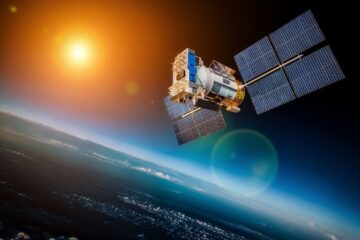
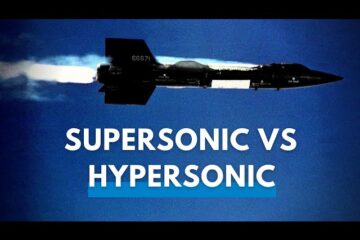
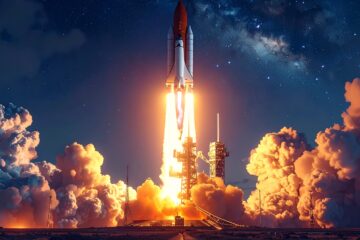
0 Comments